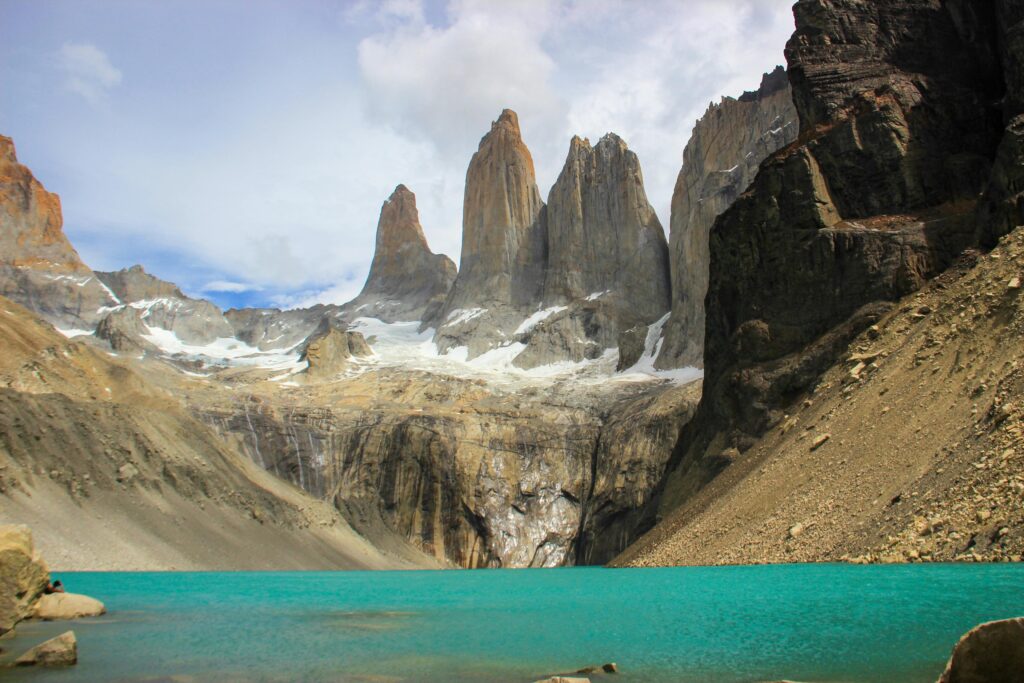Overview
Torres del Paine National Park, located in the southern Chilean Patagonia, is one of the most spectacular and renowned hiking destinations in the world. The park, established in 1959 and designated a UNESCO Biosphere Reserve in 1978, covers an area of approximately 2,400 square kilometres (927 square miles). It is famed for its dramatic landscapes, which include towering granite peaks, glistening glaciers, turquoise lakes, and sprawling pampas.
The Iconic “Torres”
The park’s name, Torres del Paine, translates to “Towers of Paine” and refers to the three distinctive granite towers that dominate the landscape. These iconic peaks, named Torre Sur (2,850 meters/9,350 feet), Torre Central (2,800 meters/9,186 feet), and Torre Norte (2,600 meters/8,530 feet), are a major draw for hikers and climbers from around the globe.

Hiking Routes
Torres del Paine offers several renowned hiking routes, catering to various levels of fitness and experience. The most famous treks are the “W” Trek and the “O” Circuit.
The “W” Trek
- Duration: 4-5 days
- Distance: Approximately 80 kilometers (50 miles)
- Highlights: The “W” Trek is named for its distinctive shape and is the most popular route in the park. Key highlights include:
- Base of the Towers: A challenging hike to the base of the Torres, offering stunning views of the three granite towers rising above a glacial lake.
- French Valley: Known for its dramatic landscapes, including the Paine Horns and hanging glaciers.
- Grey Glacier: A spectacular sight, with icebergs floating on Lake Grey and views of the massive glacier extending into the distance.
The “O” Circuit
- Duration: 7-9 days
- Distance: Approximately 130 kilometers (81 miles)
- Highlights: The “O” Circuit is a more extended and challenging route that encircles the entire Paine Massif. In addition to the highlights of the “W” Trek, it includes:
- John Gardner Pass: The highest point on the circuit, offering breathtaking panoramic views of the Southern Patagonian Ice Field.
- Serón and Dickson Camps: More remote and less frequented areas, providing a sense of solitude and connection with nature.
Ecosystems and Wildlife
Torres del Paine boasts a rich diversity of ecosystems, from windswept grasslands and dense forests to alpine regions and wetlands. This diversity supports a wide range of flora and fauna.
- Flora: The park is home to lenga and ñire forests, as well as a variety of shrubs and wildflowers, including the iconic firebush (notro) and the delicate orchid.
- Fauna: Wildlife enthusiasts can spot guanacos (a relative of the llama), Andean condors, Chilean flamingos, and the elusive puma. The park also hosts numerous bird species, making it a birdwatcher’s paradise.
Weather and Best Time to Visit
The weather in Torres del Paine is notoriously unpredictable, with conditions that can change rapidly. Visitors should be prepared for strong winds, rain, and sudden temperature drops, even during the summer months (November to March).
- Summer (November to March): This is the best time to visit, with longer daylight hours and relatively milder weather. It is also the busiest season, so advance reservations for campsites and lodges are essential.
- Shoulder Seasons (October and April): These months offer fewer crowds and still-accessible trails, though weather conditions can be more variable.
- Winter (May to September): Winter brings snow and colder temperatures, making some trails inaccessible. However, it also offers a unique and tranquil experience for well-prepared and experienced hikers.
Accommodations and Facilities
The park offers a range of accommodations, from basic campsites to more comfortable refugios (mountain lodges) and luxury eco-lodges.
- Campsites: There are numerous campsites along the main trekking routes, providing basic facilities like toilets and cooking areas. Reservations are required, especially during peak season.
- Refugios: These mountain lodges offer dormitory-style accommodation with meals included, providing a more comfortable option for trekkers.
- Eco-Lodges: For those seeking more luxury, eco-lodges within and around the park offer private rooms, gourmet dining, and guided excursions.
Environmental Conservation
Torres del Paine National Park is committed to sustainable tourism and environmental conservation. Efforts are made to minimize human impact, protect native species, and maintain the park’s pristine landscapes.
- Leave No Trace: Visitors are encouraged to follow Leave No Trace principles, including packing out all waste and minimizing their ecological footprint.
- Regulated Access: The park regulates the number of visitors and requires permits for certain areas to prevent overcrowding and overuse.
- Education and Awareness: Rangers and guides provide educational information about the park’s ecosystems, wildlife, and conservation efforts.
Conclusion
Torres del Paine National Park is a bucket-list destination for hikers and nature lovers, offering some of the most dramatic and varied landscapes in the world. Whether embarking on the famous “W” Trek, the challenging “O” Circuit, or shorter day hikes, visitors are rewarded with stunning views, rich biodiversity, and a profound sense of connection with one of the planet’s most pristine natural environments.